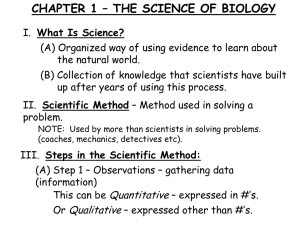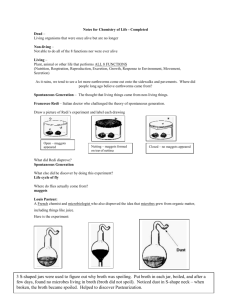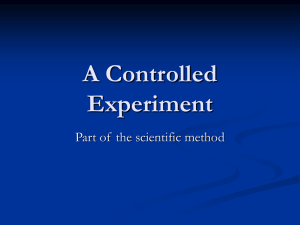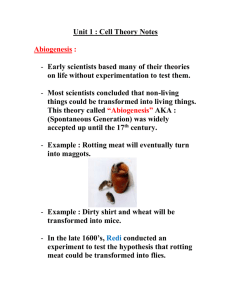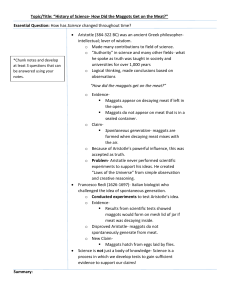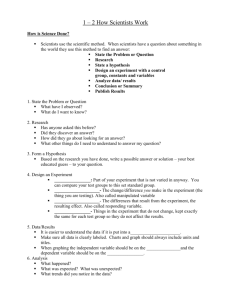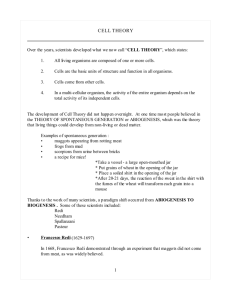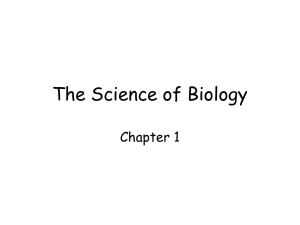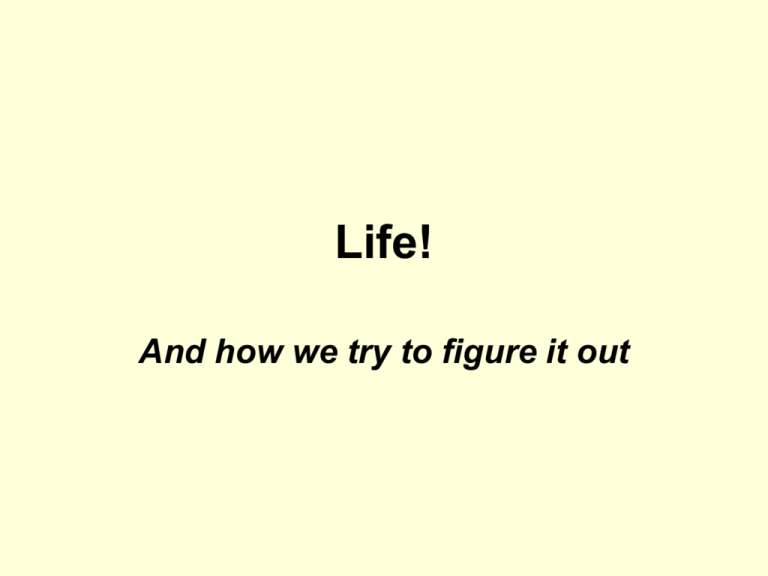
Life!
And how we try to figure it out
Figure 1.2 The hierarchy of biological organization
Biology
• Define life (good luck!).
• How do we know a living thing
when we see one?
– list characteristics common to
ALL living things.
Characteristics of all living things:
1. Made Up of Cells - Organization
2. Reproduction
3. Based on DNA
4. Growth and Development
5. Need for Energy
6. Response to Environmental Stimuli
7. Homeostasis
8. Evolution
What makes Biology a science?
• How do you know science
when you see it?
– list some characteristics of
science and describe how
scientists work.
Science is…
•
•
•
•
Objective
Data driven
Experimental
Attempt to find the best possible
naturally occurring explanation for
a phenomenon.
Observations are objective
• Observe the familiar actions and
describe them. No talking!
• Compare notes with others – how
objective were your observations?
• What happens when new observations
don’t fit with the old?
• How did observations lead to
hypotheses on life?
Where does life come from?
• At least by Aristotle’s time, people were
concerned with this.
• Prevailing theory: Spontaneous
generation or Abiogenesis
– Life comes from non-living things.
– Based on everyday observations
– Aristotle described an “active principle”
that was responsible.
Abiogenesis examples
• Salamanders and frogs come from river
mud.
• Mice come from wheat that has been
exposed to sweat.
• Humans???
– pregnancy and birth were understood,
sexual intercourse was important, but
sperm and eggs didn’t play a role!
Really small life?
• Microscopes allowed observation of
micro-organisms, but these were
thought to come from plants or mud
mixed with water (van Leeuwenhoek,
mid 1600’s).
• Bacteria in meat broth were formed
from the meat (Needham, 1745).
An alternative view: Biogenesis
• By the mid 17th century some
individuals questioned abiogenesis.
• Their observations suggested all living
things were produced by other living
things
– Biogenesis
• A test of biogenesis/abiogenesis
was needed!
Francisco Redi
• 1668: An Italian physician decided to
test the “common knowledge” that
maggots came from rotting meat.
– Without refrigeration or concern about
covering food, maggots tended to appear
on meat within a few days. Therefore, the
meat produced the maggots.
Redi’s Alternative:
• OBSERVATION: Flies land on meat
that is left uncovered. Later,
maggots appear on the meat.
• HYPOTHESIS: Flies produce
maggots.
Redi’s Experimental Design
• If flies are kept away from meat by a
covering, no maggots should appear.
• Compare to meat stored in the usual
way (uncovered) which should develop
maggots.
• Keep every other factor the same!
The variables:
• Independent variable:
–covering over jar or not
• Controls fly access to meat
• Controlled Variables:
–jars, type of meat, location,
temperature, time
• Dependent variable:
–maggots?
Procedure
Uncovered jars
Covered jars
Several
days pass
?
?
Results
Uncovered jars
Covered jars
Several
days pass
Maggots appear
No maggots appear
CONCLUSION:
• Maggots form only when flies
come in contact with meat.
– Spontaneous generation of
maggots did not occur.
Figure 1-10 Spallanzani’s
Experiment
Spallanzani’s Experiment: 1765
Gravy is boiled.
Flask is
open.
Gravy is teeming
with
microorganisms.
Gravy is boiled.
Flask is
sealed.
Gravy is free of
microorganisms.
Pasteur’s Experiment: 1860
Broth is boiled.
Pasteur
Broth is boiled.
Broth is free of
microorganisms
for a year.
Pasteur
Broth is boiled.
Broth is free of
microorganisms
for a year.
Curved neck
is removed.
Pasteur
Broth is boiled.
Broth is free of
microorganisms
for a year.
Curved neck
is removed.
Broth is
teeming with
microorganisms.
Biogenesis wins!
• Pasteur’s experiments finally won
general support for the biological
origins of living things.
• Pasteur also introduced methods of
food preservation (Pasteurization!) that
dramatically increased the shelf life of
foods.
But wait! There’s more!
• Where did the FIRST living thing
come from???
• Where did the universe come
from???
• Let’s start with nonliving things
and how they affect living things.
• Abiotic vs Biotic factors!

